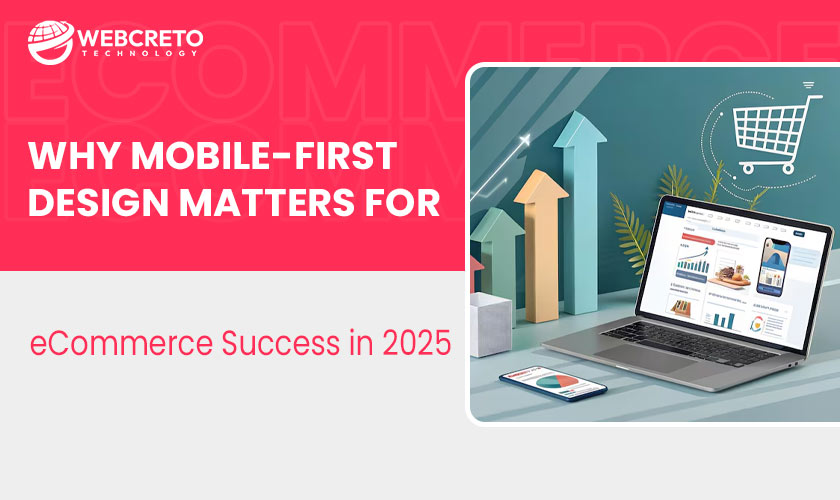Mobile commerce is booming, and businesses that ignore it risk losing customers and revenue. A mobile-first approach ensures that your eCommerce website is optimized for the devices your audience uses the most. Leveraging professional ecommerce design services and custom ecommerce website development, brands can create seamless, high-converting mobile experiences that drive growth in 2025 and beyond.
The Rise of Mobile Commerce in 2025
- Mobile shopping now dominates online sales globally.
- Consumers increasingly rely on smartphones for browsing, comparing, and purchasing products.
- Businesses must adapt with mobile-first strategies or face reduced engagement and conversions.
What Is Mobile-First Design?
Mobile-first design is the practice of designing a website primarily for mobile devices before scaling it up for larger screens. Unlike traditional responsive design, which adapts desktop layouts for mobile, mobile-first ensures that mobile usability drives the design decisions. Custom ecommerce website development implements these principles for tailored, high-performing websites.
Why Mobile-First Design Is Crucial for eCommerce Success
Improved User Experience
- Streamlined navigation, touch-friendly interfaces, and simplified layouts enhance usability.
- Ecommerce design services help create intuitive experiences that reduce bounce rates.
Faster Load Times
- Mobile-first optimization ensures faster page load speeds.
- Speed improvements directly impact conversion rates and user satisfaction.
Higher Conversion Rates
- Mobile-optimized checkout processes simplify purchasing.
- Custom ecommerce website development can tailor funnels for mobile conversion efficiency.
SEO Advantages
- Google uses mobile-first indexing, making mobile optimization essential for search rankings.
- Better mobile usability improves organic visibility.
Competitive Edge in 2025
- Brands with mobile-first websites outperform competitors in engagement, sales, and loyalty.
- Professional ecommerce design services give businesses an edge by implementing best practices.
Key Elements of Mobile-First eCommerce Design
Simplified Navigation & Menus
Optimized Images and Media
Mobile-Friendly Checkout Experience
Touch-Friendly Buttons & CTAs
Clear Typography and Readability
- All elements designed in alignment with custom ecommerce website development standards.
How Ecommerce Design Services Help Build Mobile-First Websites
- Conduct UX research to understand mobile shopper behavior.
- Implement adaptive layouts and responsive grids.
- Test across devices to ensure consistent performance.
- Continuously optimize for conversions and speed.
Case Studies: Mobile-First Success Stories
- Small Business: Scaled sales by 50% with mobile-first redesign via ecommerce design services.
- Enterprise Brand: Improved checkout conversions by 35% using custom ecommerce website development.
Choosing the Right Ecommerce Design Partner in 2025
- Look for experience with mobile-first projects.
- Evaluate expertise in both ecommerce design services and custom ecommerce website development.
- Consider a partner who provides ongoing optimization and analytics support.
Conclusion
Mobile-first design is no longer optional; it’s essential for eCommerce success in 2025. By working with professional ecommerce design services and investing in custom ecommerce website development, businesses can create fast, intuitive, and conversion-focused websites that outperform the competition.
Also know more about: Custom vs. Template: Which eCommerce Website Solution Is Right for You?
FAQs
Q1. What is mobile-first design in eCommerce?
Designing websites primarily for mobile devices to ensure usability, performance, and conversions on smartphones and tablets.
Q2. Why are ecommerce design services important for mobile-first websites?
They provide expertise in creating user-friendly, high-performing mobile sites that enhance user experience and drive conversions.
Q3. How does custom ecommerce website development help?
It allows tailored designs, scalable solutions, and optimized checkout flows specifically for mobile users.
Q4. Is mobile-first design necessary for all businesses?
Yes, especially since mobile traffic now accounts for the majority of eCommerce interactions.
Q5. How can I measure the success of mobile-first eCommerce design?
Monitor mobile traffic, bounce rates, conversion rates, page load speed, and customer engagement metrics.


Leave a Reply